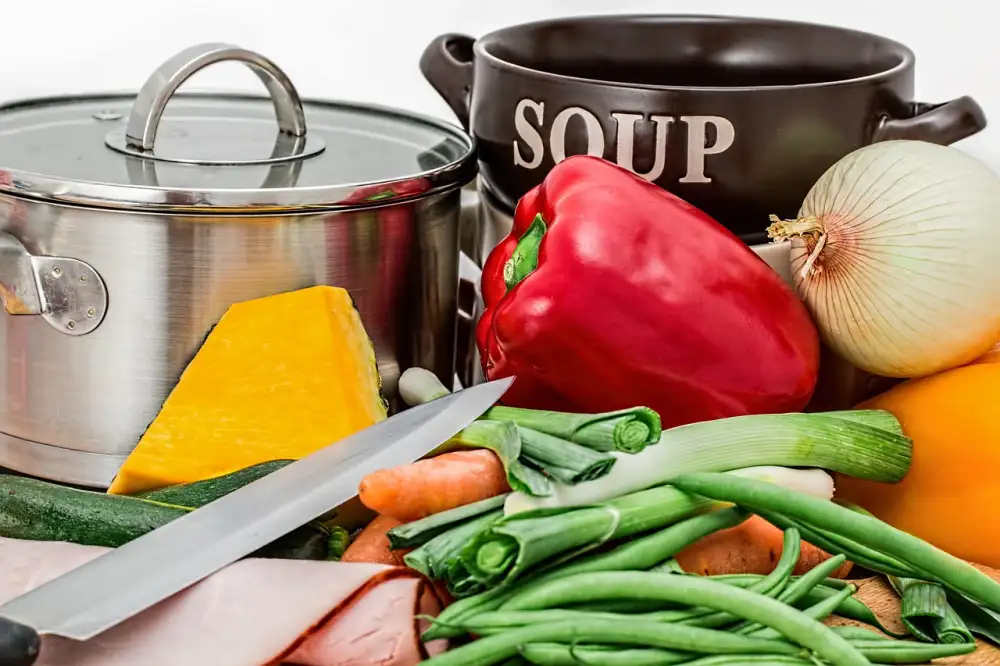Delicious and Nutritious Baby Weaning Recipes: Elevate Your Little One's Solid Food Journey at Home

- Benefits of Introducing Solid Foods to Babies
- When to Start Baby Weaning
- Essential Nutrients for Baby's Growth and Development
- Safety Tips for Introducing Solid Foods
- Simple and Nutritious Baby Weaning Recipes:
- 1. Homemade Baby Cereal
- 2. Pureed Fruits and Vegetables
- 3. Soft Cooked Grains and Legumes
- 4. Mashed Proteins: Meat and Fish
- 5. Finger Foods for Self-Feeding
- Tips for Making Baby Weaning Recipes
Introducing solid foods to your baby is an exciting milestone in their development. As they transition from milk to solid foods, it's important to provide them with nutritious and delicious meals. Baby weaning recipes are specially designed to meet the nutritional needs of your little one while introducing them to a variety of flavors and textures. In this article, we will explore the benefits of introducing solid foods, when to start baby weaning, essential nutrients for growth and development, safety tips, and simple yet nutritious recipes that you can easily prepare at home. So let's embark on this journey of nourishing your baby's taste buds and helping them develop a healthy relationship with food.
Benefits of Introducing Solid Foods to Babies
Introducing solid foods to babies brings numerous benefits to their overall growth and development. Firstly, it provides them with a wider range of nutrients essential for their growing bodies. Solid foods offer a variety of vitamins, minerals, and proteins that breast milk or formula alone cannot provide. Secondly, introducing solids helps develop their taste buds and encourages them to explore different flavors and textures. This early exposure to various tastes can lead to a more adventurous eater in the future. Lastly, the act of self-feeding promotes fine motor skills and hand-eye coordination. Allowing babies to feed themselves with finger foods helps develop their independence and confidence. Overall, introducing solid foods is an exciting milestone that enhances both nutritional intake and developmental skills in babies.
When to Start Baby Weaning
The timing for introducing solid foods to your baby is an important decision. The American Academy of Pediatrics recommends starting baby weaning around 6 months of age. By this time, most babies have developed the necessary skills to eat solid foods and their digestive systems are more mature.
It's crucial to wait until your baby is physically ready for solids. Look for signs such as sitting up with minimal support, showing interest in what you're eating, and being able to hold their head steady. Starting too early can increase the risk of choking and digestive issues.
Remember that every baby is different, so it's essential to consult with your pediatrician before starting the weaning process. They will be able to guide you based on your baby's individual needs and development.
Essential Nutrients for Baby's Growth and Development
When introducing solid foods to your baby, it is crucial to ensure that they receive the necessary nutrients for their growth and development. Here are some essential nutrients to include in their diet:
1. Iron: Iron is vital for brain development and the production of red blood cells. Include iron-rich foods like fortified cereals, pureed meats, beans, and leafy greens.
2. Calcium: Calcium is essential for strong bones and teeth. Offer dairy products like yogurt and cheese or calcium-fortified alternatives.
3. Vitamin D: Vitamin D aids in calcium absorption and supports bone health. Expose your baby to sunlight or provide vitamin D-fortified foods such as fatty fish or fortified milk.
4. Protein: Protein is crucial for muscle and tissue development. Introduce pureed meats, poultry, fish, tofu, or legumes to meet their protein needs.
5. Healthy Fats: Healthy fats are important for brain development. Include avocados, nut butters, olive oil, or fatty fish like salmon in their meals.
Remember to introduce these nutrients gradually while ensuring a balanced diet for your little one's optimal growth and development.
Safety Tips for Introducing Solid Foods
1. Start with single ingredients: Introduce one new food at a time to identify any potential allergies or intolerances.
2. Watch for signs of allergies: Look out for symptoms like rashes, vomiting, or diarrhea after introducing a new food. If any occur, consult your pediatrician.
3. Avoid choking hazards: Cut foods into small, soft pieces and avoid hard, round foods like whole grapes or nuts.
4. Supervise mealtime: Always be present when your baby is eating to ensure they are chewing and swallowing properly.
5. Gradually increase texture: Start with purees and gradually introduce thicker textures as your baby gets more comfortable with solid foods.
6. Offer water in a cup: Introduce sips of water from a cup alongside solid foods to encourage proper hydration.
7. Be mindful of salt and sugar intake: Avoid adding salt or sugar to your baby's meals as their kidneys are still developing and excessive intake can be harmful.
Remember, every baby is different, so consult with your pediatrician for personalized advice on introducing solid foods safely.
Simple and Nutritious Baby Weaning Recipes:
6. Simple and Nutritious Baby Weaning Recipes:
When it comes to introducing solid foods to your baby, simplicity and nutrition are key. Here are some easy and healthy baby weaning recipes to kickstart your little one's culinary journey:
6.1. Homemade Baby Cereal: Start with a basic cereal made from whole grains like rice or oats. Cook them until soft and blend into a smooth consistency using breast milk or formula.
6.2. Pureed Fruits and Vegetables: Introduce a variety of fruits and vegetables by steaming or boiling them until tender, then pureeing them into a smooth texture. Try options like sweet potatoes, carrots, apples, or bananas.
6.3. Soft Cooked Grains and Legumes: Cook grains like quinoa or millet until they are soft enough for your baby to easily chew and swallow. Similarly, cook legumes such as lentils or chickpeas until they are soft and mashable.
6.4. Mashed Proteins: Meat and Fish: As your baby grows older, you can introduce mashed proteins like chicken or fish into their diet. Ensure that the meat is cooked thoroughly and mashed into a safe consistency for easy digestion.
6.5. Finger Foods for Self-Feeding: When your baby is ready for self-feeding, offer small pieces of soft fruits like avocado or ripe mangoes, cooked pasta shapes, or well-cooked vegetables cut into manageable sizes.
These simple recipes provide essential nutrients while introducing new flavors and textures to your baby's palate. Remember to consult with your pediatrician before introducing any new foods and always prioritize safety during mealtime.
1. Homemade Baby Cereal
6.1 Homemade Baby Cereal:
One of the first foods to introduce to your baby is homemade baby cereal. It is a great source of essential nutrients like iron and can be easily prepared at home. Start by grinding rice or oats into a fine powder using a blender or food processor. Cook the powder with water or breast milk until it thickens to a smooth consistency. You can also add pureed fruits for added flavor and nutrition. Serve it warm and watch your little one enjoy this nutritious meal!
2. Pureed Fruits and Vegetables
Pureed fruits and vegetables are a great way to introduce different flavors and textures to your baby's diet. They are packed with essential vitamins, minerals, and fiber that promote healthy growth and development. Start with single-ingredient purees such as mashed bananas, steamed carrots, or cooked apples. As your baby gets used to the taste and texture, you can gradually introduce combinations like sweet potato and pear or avocado and spinach. Remember to always use fresh produce and steam or boil them until they are soft enough to be easily mashed.
3. Soft Cooked Grains and Legumes
Soft Cooked Grains and Legumes are a great addition to your baby's weaning journey. They provide essential nutrients like carbohydrates, protein, and fiber for their growth and development. Start with easily digestible options like rice, oats, quinoa, or lentils. Cook them until they are soft and mushy, making it easier for your little one to eat and swallow. You can also mix them with pureed fruits or vegetables for added flavor and nutrition. Remember to introduce one new grain or legume at a time to check for any allergies or sensitivities.
4. Mashed Proteins: Meat and Fish
Mashed Proteins: Meat and Fish
As your baby grows, it's important to introduce mashed proteins into their diet. Meat and fish are excellent sources of essential nutrients like iron, zinc, and omega-3 fatty acids, which are crucial for their growth and development.
When preparing mashed proteins for your little one, ensure that the meat or fish is cooked thoroughly and is tender enough to be easily mashed. You can start with lean meats like chicken or turkey, or opt for fish like salmon or cod.
To make a simple mashed protein recipe, cook the meat or fish until it's fully cooked and then mash it using a fork or blender. You can also add some breast milk or formula to make it smoother and easier for your baby to swallow.
Remember to remove any bones from the meat or fish before mashing it. It's also important to avoid adding salt, spices, or seasonings as they may not be suitable for your baby's delicate palate.
Introducing mashed proteins will not only provide your baby with important nutrients but also help them develop their chewing skills. Start with small portions and gradually increase the amount as they become more comfortable with solid foods.
Always consult with your pediatrician before introducing new foods to ensure that they are appropriate for your baby's age and development stage. With these delicious mashed protein recipes, you can elevate your little one's solid food journey while ensuring they receive all the necessary nutrients for healthy growth.
5. Finger Foods for Self-Feeding
6.5. Finger Foods for Self-Feeding
As your baby grows older and becomes more independent, introducing finger foods is a great way to encourage self-feeding and develop their fine motor skills. These bite-sized pieces of food are easy for little hands to grasp and can be a fun sensory experience for your baby.
When choosing finger foods, it's important to opt for soft and easily chewable options to prevent choking hazards. Some excellent choices include small cubes of cooked vegetables like sweet potatoes or carrots, soft fruits like bananas or avocados, and small pieces of cheese or tofu.
You can also introduce small portions of pasta or well-cooked grains like rice or quinoa. These foods provide essential carbohydrates and energy for your growing baby.
Remember to always supervise your baby during mealtime and cut the finger foods into appropriate sizes to reduce the risk of choking. Encourage your little one to explore different textures and tastes by offering a variety of finger foods on their high chair tray.
By introducing finger foods, you not only promote self-feeding but also allow your baby to develop their taste preferences and independence in choosing what they want to eat. It's an exciting milestone in their solid food journey that will help them become confident eaters in the future.
Tips for Making Baby Weaning Recipes
1. Start with simple flavors: Introduce one ingredient at a time to identify any potential allergies or sensitivities.
2. Use fresh and organic ingredients: Opt for locally sourced fruits, vegetables, grains, and proteins to provide the best nutrients for your little one.
3. Steam or bake instead of boiling: This helps retain more nutrients in the food while making it easier to mash or puree.
4. Experiment with different textures: Gradually increase the thickness of the purees or introduce soft, mashed foods to help develop your baby's chewing skills.
5. Be creative with seasoning: Add a pinch of herbs or spices like cinnamon or nutmeg to enhance the flavor of the dishes without adding salt or sugar.
6. Invest in good quality kitchen tools: A blender, food processor, and steamer can make preparing baby weaning recipes much easier and quicker.
7. Store leftovers properly: Use ice cube trays or small containers to freeze individual portions for future meals. Label and date them to ensure freshness.
Remember, every baby is unique, so observe their reactions and adjust recipes accordingly. Enjoy this exciting journey of introducing solid foods to your little one!
Introducing solid foods to your baby is an exciting milestone that opens up a whole new world of flavors and textures. By providing nutritious homemade baby weaning recipes, you can ensure that your little one gets the best start in their solid food journey.
Remember to introduce foods gradually, starting with simple purees and gradually moving on to more complex textures. This will help your baby develop their taste buds and chewing skills.
By incorporating a variety of fruits, vegetables, grains, legumes, proteins, and finger foods into their diet, you can provide essential nutrients for their growth and development. These nutrients are crucial for building a strong immune system, supporting brain development, and promoting overall health.
As you embark on this journey with your baby, always prioritize safety by following proper hygiene practices and introducing one new food at a time to monitor for any potential allergies or reactions.
With these simple tips and nutritious recipes at hand, you can elevate your little one's solid food journey at home. Enjoy this special time of exploration and nourishment as you watch them grow into healthy eaters with a love for delicious and nutritious foods.
Published: 31. 12. 2023
Category: Home



